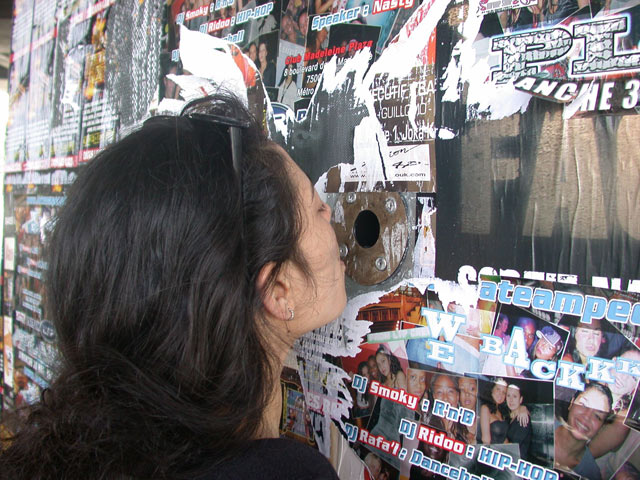LOUD SPEAKERS, SILENT LISTENERS
by Helen Evans for Cluster Magasine issue 04, Torino, Italy, January 2005

Micro blindé by Julien Saglio. photo by Saglio, 2004
It’s all about public space. At the three Biennales of Contemporary Art in Seine St-Denis titled ‘Nature Urbaine’, ‘E-Art’ and ‘Art Grandeur Nature’, art and media design takes a critical look at what it means to be ‘public’.
So what and where is public space? In « Nature Urbaine » the advertising surfaces of the city streets have been redirected and life on the streets of St Ouen are the exhibit. Under the Paris Periphérique (the 4 lane motorway that circles this city) a low bass booms and a small crowd of people have gathered. Fixed to the wall is an impenetrable 3 x 4 metre box of steel, a street furniture installation by Julian Saglio “Micro blindé” (Armoured mike), a powerful sound system that lets you plug in any audio device and offers an open mike to anyone that has something public to say.
At first, some members of the local community were suspicious. “There was a process of getting the work to settle into an environment where multiple human relations unfold” explains Saglio. Scheduled during peak hour on the market, members of the hip-hop dance association “Moovin’ Aktion” launched into a freestyle performance of rap and break dance, rocking rhythms at full volume. Passers by naturally gathered and people continued to play tunes despite the watchful eye of the military Police (CRS). Break-dancers, mix tape sellers, video makers and record label promoters have all appropriated the installation for their own ends. One week later, “Micro blindé” is covered with illegal fly posters, disappearing into the urban environment. Users help maintain the work, piercing holes into the posters, releasing the sound back into the public. The installation creates a new type of street activity, where individuals perform and broadcast. Against a backdrop of heavy traffic and commotion, it acts as public stage, a place where loud sounds and free speech are permitted.
Why is there a focus on the physical aspect of public space at this moment in time? Perhaps because public space has become so completely dull. Public space is controlled and regulated, and any artist who intervenes in this space needs patience and persistence in order to obtain permission from the authorities as well as the talent to adapt an idea to an outdoor space. On the other hand, advertising space, once the business deal is in place, is not at all controlled in the same way, provided advertisers stay within the ‘acceptable’ moral codes. This in-balance might be the reason that architects, designers and artists are slowly working their way into the streets, in the hope that we might do all kind of things we would not normally do, in places under motorways, parks and busy roads, to speak, project, amplify, measure and question each other.
Amongst the other exhibits, an illuminated advertising box, by Heiko Hansen and I, transformed into a shifting noise pollution monitor. Using an array of giant electronic number displays, the installation literally and metaphorically reconstructs an image out of numbers. Bruit rose (Pink noise) moves to the environmental sounds of heavy road traffic giving visual clues about the state of the environment. Steffen Rault’s “Galerie Mobile Interactive” is a both physical and a virtual exhibit within a park. People access the local wifi network from a mobile server within the space, which automatically redirected them to an exclusive, local webpage, documenting local history and his photographic intervention. Using a more traditional advertising technique, Olga Kisseleva shows seven photographs within a suite of advertising stands, using one word and its counter image, to express the principal desires of local children growing up in the twenty-first century: Beauty, Power, Respect, Fame, Wealth, Pleasure and Success. Closing the circle, a video in the local Quick (a French hamburger chain) shows the interviews she made with the local children.
Perhaps publicity is an ideal platform for reinventing the public: publicity is a fusion of the word ‘public’ with ‘city’. Not content with simply changing the message, these installations offer new functions for the publicity panel, generating a new kind of public space. The installations in Nature Urbaine manage to express very different ideas of what should be ‘public’, such as self-expression, participation, exchange, pollution and reflection.
But what does become clear in Nature Urbaine is the difficulty of working in public space: from dealing with conflicting interests of the many people that use a given space to designing works that will withstand bad treatment and remain functioning. “Armoured mike” in its title and construction expresses an un-romanticised reality of designing for the public. The works have to be strongly protected, or even shielded from the public, if they are to withstand abuse and serve their function. Engaging the public in making new activities is a difficult challenge. The artists in “Nature Urbaine” are stepping back and listening, holding the microphone out to the public and letting the city speak.Nature Urbaine, St Ouen 93400 France from May 15 – July 15 2004
Nature Urbaine was curated by Mathieu Marguerin.
Art Grandeur Nature was organised by the Conseil Générale de la Seine St Denis in partnership with Mainsd'oeuvres and Synesthesie.

Micro blindé by Julien Saglio. photo by Saglio, 2004